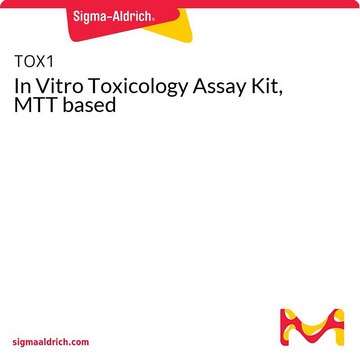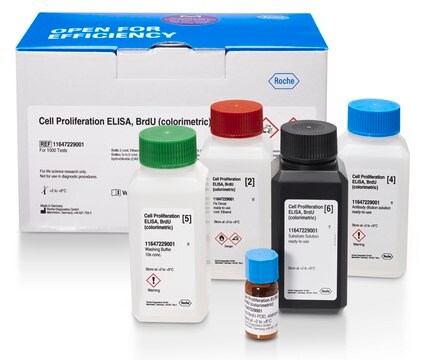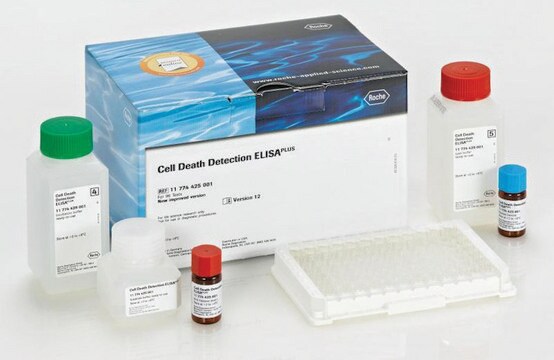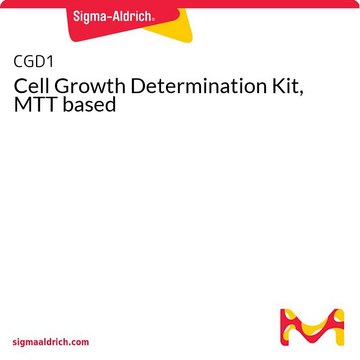11644793001
Roche
Cytotoxicity Detection Kit (LDH)
suitable for protein quantification, suitable for cell analysis, detection, sufficient for ≤2,000 tests
Synonym(s):
LDH
Sign Into View Organizational & Contract Pricing
All Photos(1)
About This Item
UNSPSC Code:
12352200
Recommended Products
usage
sufficient for ≤2,000 tests
Quality Level
packaging
pkg of 1 kit
manufacturer/tradename
Roche
technique(s)
protein quantification: suitable
λmax
490 nm
application(s)
cell analysis
detection
detection method
colorimetric
storage temp.
−20°C
General description
A nonradioactive alternative to the [51Cr] and [3H]-thymidine release assay.
Colorimetric assay for the quantification of cell death and cell lysis, based on the measurement of lactate dehydrogenase (LDH) activity released from the cytosol of damaged cells into the supernatant.
Colorimetric assay for the quantification of cell death and cell lysis, based on the measurement of lactate dehydrogenase (LDH) activity released from the cytosol of damaged cells into the supernatant.
Application
The Cytotoxicity Detection Kit (LDH) is a fast and simple method to quantify cytotoxicity/cytolysis based on the measurement of LDH activity released from damaged cells using the 96-well plate format. Thus, the kit can be used in many different in vitro cell systems when damage to the plasma membrane occurs. For example:
- Detection and quantification of cell-mediated cytotoxicity
- Determination of mediator-induced cytolysis
- Determination of the cytotoxic potential of compounds in environmental and medical research, and in the food, cosmetic, and pharmaceutical industries
- Determination of cell death in bioreactors
- Testing of biocompatibility of various scaffolds, employed in bone tissue engineering, for bone cell growth
Packaging
1 kit containing 2 components.
Preparation Note
Working solution: Vial 1 Catalyst:
Reconstitute the lyophilisate in 1 ml double dist. water for 10 minutes and mix thoroughly.
Vial 2 Dye solution:
Ready-to-use solution.
Reaction mixture
For 100 tests: Shortly before use, mix 250 μl of vial 1 with 11.25 ml of vial 2.
For 400 tests: Shortly before use, add the total volume of catalyst (1 ml) to the total volume
of dye solution (45 ml) and mix well.
Note: The Reaction mixture should not be stored; prepare immediately before use.
Storage conditions (working solution): 2 to 8 °C
The lyophilizate is stable at 2 to 8 °C.
The reconstituted catalyst solution is stable for four weeks when stored at 2 to 8 °C.
Once thawed, the dye solution is stable for several weeks when stored at 2 to 8 °C.
Reconstitute the lyophilisate in 1 ml double dist. water for 10 minutes and mix thoroughly.
Vial 2 Dye solution:
Ready-to-use solution.
Reaction mixture
For 100 tests: Shortly before use, mix 250 μl of vial 1 with 11.25 ml of vial 2.
For 400 tests: Shortly before use, add the total volume of catalyst (1 ml) to the total volume
of dye solution (45 ml) and mix well.
Note: The Reaction mixture should not be stored; prepare immediately before use.
Storage conditions (working solution): 2 to 8 °C
The lyophilizate is stable at 2 to 8 °C.
The reconstituted catalyst solution is stable for four weeks when stored at 2 to 8 °C.
Once thawed, the dye solution is stable for several weeks when stored at 2 to 8 °C.
Kit Components Only
Product No.
Description
- Catalyst (Diaphorase/NAD+ mixture)
- Dye Solution (INT and sodium lactate)
related product
Product No.
Description
Pricing
Signal Word
Warning
Hazard Statements
Precautionary Statements
Hazard Classifications
Eye Irrit. 2
Storage Class Code
12 - Non Combustible Liquids
WGK
WGK 1
Flash Point(F)
does not flash
Flash Point(C)
does not flash
Choose from one of the most recent versions:
Already Own This Product?
Find documentation for the products that you have recently purchased in the Document Library.
Customers Also Viewed
Gayle E Derfus et al.
mAbs, 6(3), 679-688 (2014-02-21)
While many antibody therapeutics are formulated at low concentration (~10-20 mg/mL) for intravenous administration, high concentration (> 100 mg/mL) formulations may be required for subcutaneous delivery in certain clinical indications. For such high concentration formulations, product color is more apparent
Sabine Sewing et al.
PloS one, 11(7), e0159431-e0159431 (2016-07-22)
Single stranded oligonucleotides (SSO) represent a novel therapeutic modality that opens new space to address previously undruggable targets. In spite of their proven efficacy, the development of promising SSO drug candidates has been limited by reported cases of SSO-associated hepatotoxicity.
Guo-qian He et al.
Molecular brain, 8, 88-88 (2015-12-25)
Growth arrest and DNA-damage inducible protein 45 beta (Gadd45b) is serving as a neuronal activity sensor. Brain ischemia induces the expression of Gadd45b, which stimulates recovery after stroke and may play a protective role in cerebral ischemia. However, little is
Volker Gassling et al.
Clinical oral implants research, 24(3), 320-328 (2011-11-19)
The loss of jaw bone caused by different kinds of pathologies leads to dysfunction and reduced quality of life in affected patients. Thus, the pivotal goal in bone tissue engineering is to reconstruct these defects. The essential precondition for new
Kacper A Wojtal et al.
American journal of physiology. Gastrointestinal and liver physiology, 307(7), G673-G688 (2014-06-28)
Solute carrier (SLC) transporters mediate the uptake of biologically active compounds in the intestine. Reduced oxygenation (hypoxia) is an important factor influencing intestinal homeostasis. The aim of this study was to investigate the pathophysiological consequences of hypoxia on the expression
Our team of scientists has experience in all areas of research including Life Science, Material Science, Chemical Synthesis, Chromatography, Analytical and many others.
Contact Technical Service













